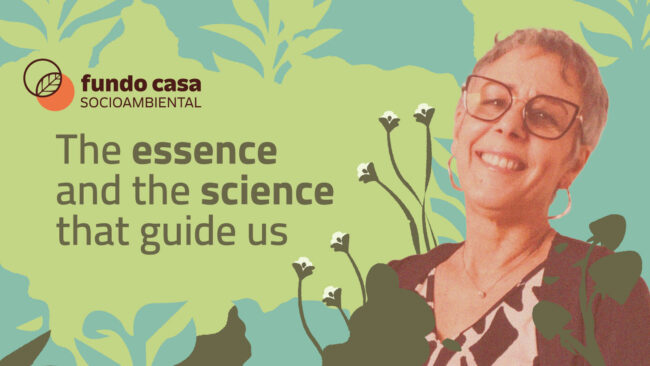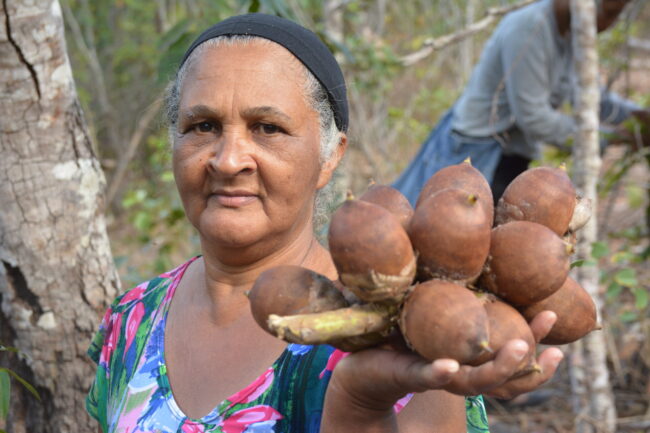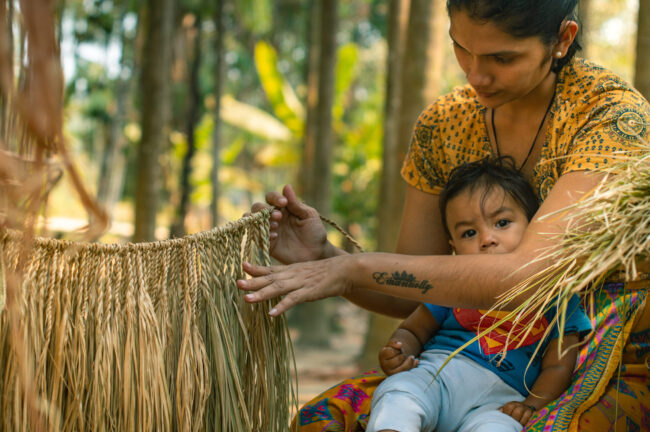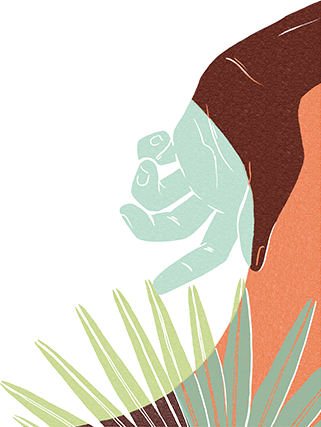 29.11.2023
29.11.2023
The essence and science that guide us
By Maria Amália Souza – Founder and Director of Strategic Development
Casa Socio-Environmental Fund has shown “what it came for” in the past 18 years. Evidence of our efficiency is apparent in various forms, not only in our ability to support a growing number of community-based groups in a way that, combined, we can demonstrate significant positive advancements in the causes we embrace, but also in our recognized role within the philanthropic field, national and most of all international.
This evidence is in the number of project funding calls for that we launch, many times simultaneously, every year. It can be seen in the alliances among funds and in the philanthropic networks in which we operate, which make the impact of our support ever more comprehensive and visible. It is in the range of actions and approaches in which our team acts in a serious, representative, and heart warming manner. And it is in the ample recognition that we have achieved in the most varied fields of activity. All of this can be found in the numerous studies, publications and reports that we have produced in recent years.
Until today, we have told our story in a playful and empirical way. In this narrative, it is possible to clearly perceive our solid path of dedication and our long history of profound collective experiences, which have guided us to the choices of action in this field leading to achieve maximum efficiency. However, something we have never done until now, is to tell in detail the science behind the way we developed our operating model. And believe me when I say there’s a lot of science here!
Our model is deeply rooted in the teachings of two great scientists: Donella (Dana) Meadows and Joanna Macy. It’s time to recognize and better explain how the philanthropy we do is based on the principles of Systems Dynamics, developed by MIT scientists, mainly as it relates to Dana’s work and legacy. It also draws on various aspects of Joanna’s teachings, composed by General Living Systems Theory and The Work that Reconnects, which involves principles of Deep Ecology, Eco-psychology and practices inspired by various spiritual and ancestral philosophies — a brilliant and creative process that has been tested and refined by her during her 94 years of life, and counting.
Understanding the planetary moment and our role
In the year 2000, I took my first intensive course of several to come, with Joanna Macy, in California. I was fascinated by the work of uniting solid scientific theories with practices that awaken in us humans the memory that we are but one of the millions of living beings that inhabit Planet Earth. Our cells are nothing more than recycled material (literally) from 15 billion years of planetary journey. Remembering that we are an integral and interdependent part of the Web of Life reminds us that we must work for Life and not for death.
Joanna teaches, or better reminds us, that we live in the moment of the “Great Turning” from the Industrial Growth Society to a Life Sustaining Society. We have no choice but to work for the latter. In order for us to achieve this we can act in one or more of three large dimensions — or even all simultaneously — “Holding Actions” those that protect life, or work to stop the systematic environmental destruction that we are experiencing; in the construction of “Gaia Structures”, which are new (or old rescued) ways of living in this world without destroying it; and in the “Awareness Raising” realm, remember we here to contribute to Life — a kind of consciousness that has been dormant within so many of us. We seem to be living in a zombie state that keeps us walking blind in the belief that the planet is there for us, and that consumption is unlimited, unconscious to the disastrous consequences of this state of inertia.
The Work that Reconnects involves many “awakenings” such as lovingly accepting gifts from our ancestors, deep time awareness that connects us to past and future generations, the Truth Mandala, and other experiences that validate us to “feel the pain of the world”. In Joanna’s book that I helped translate and edit, “Coming back to Life (Ed.Gaia, 2004)”, she reports a passage: “The Zen poet Thich Nhat Hanh was asked ‘What do we need to save our world?’. His answer was: ‘What we need most is to hear, within us, the sounds of the earth crying.’” We need to listen to those feelings that we carry for the planet: the fear that we will lose it gives us the confidence to act for it; sadness at the perception of so much destruction strengthens our love for life and for all living beings; the anger of seeing the blindness around us awakens our passion for action; and emptiness and discouragement also show us that there is room for a new way of life, and give us purpose.

Mrs. Nega is the president of the Cresertão Association in the Sagarana Community in Minas Gerais. The association received support for the organization of the “II Sagarana Forum: Traditional Knowledge, Culture, and Climate Change,” which promoted the development and sharing of knowledge among academic, cultural, and traditional perspectives at the local and regional levels. The forum aimed at strategies for well-being and the conservation of sociobiodiversity in the face of the global climate emergency in the year 2021. Photo: Rhaul de Oliveira.
That’s what we see in the guardians of the planet. As actors in the socio-environmental field, who come from many decades of dedication, Casa Fund’s founders and team realize that the people who offer the most protection and fight for the most important places on this planet are also those who are closest to the real feelings of constant loss in which we find ourselves today. Having been abandoned and excluded for decades, and having nothing left to offer, they protect these places with their songs, their rituals of care, their hands and their lives. They are also the ones with the most appropriate solutions, but without the platform to amplify their voices and demonstrate their capabilities. Their efforts are closely linked to Joanna’s teachings: in the Herculean work to contain the destruction, in the most innovative solutions, and, as we see more and more today in Brazil, in the strength of the ancestral voice that awakens us from our state of inertia to the broader and more universal awareness of the protection of Life.
It is in these people that Casa Fund has invested since its inception. With our 18 years of life, and more than three thousand projects supported in 10 countries, we have repeatedly confirmed that this path was the best of all bets — that only those people who have the collective way of acting and who understand what is at stake, because they are truly connected to the earth, can provide humanity with a second chance. There is no better strategy than investing in the protectors of this planet’s life centers.
Systems Thinking – the science of belonging
In 2002, I had the chance to participate in a 2-year Fellowship to learn Systems Thinking tools. This program, organized by Dana’s students at MIT and Dartmouth College — the Donella Meadows Sustainability Fellows Program — prioritized women working on the various fronts of planetary sustainability. In her book The Global Citizen (The Global Citizen-Island Press, 1991), she explains that “systems dynamics is a series of techniques […] that help its practitioners begin to understand complex systems —systems such as the human body or the national economy or the earth’s climate. Systems tools help keep track of multiple interconnections; they help us to see thing whole. Because much of conventional wisdom comes from seeing things in parts and focusing on one small part at a time, systems dynamicists tend to have surprising points of view.”
From this complex universe of teachings, some were used by Casa Fund on its conception and mechanisms of action. One of them is precisely to see the whole. We have always opted, because of the proximity of our founders with networks and relations of protection to the great South American biomes, to understand the macro to act in the micro. We always noticed that philanthropic resources arrived – and continue to arrive, due to the short sightedness of some – in huge amounts for a few large organizations and limited approaches. In the 1990s, when we started this process of finding a new path, there was literally not a penny for a movement that was being born, formed by Community-based groups that were acting in their own regions, with cheap and very efficient answers to great socio-environmental challenges.

Tapuya and his son in the Mura village of the Itapranã River in Rondônia. The community developed the project “Strengthening the alliance of Pan-Amazonian rivers on the Brazil-Bolivia border” in response to the impacts caused by the hydroelectric complex on the Madeira River. Photo: Tulasi Resende.
Because we were an integral part of this local work, and of these networks that began to develop to work together on major issues, we realized that we needed to deeply comprehend the broader context of threats, and the proposals for existing solutions for each biome. Knowing who did what, what studies were produced, what narratives were developed, who financed the destruction, who focused on these financiers to assign responsibility for the destruction (and try to stop it), who proposed solutions, and what were the solutions. We always tried to understand to what extent these solutions had traction, to what extent they managed to change the destructive processes.
We realized that there was a lot of important work being done that would only reach a certain point and was never able to truly offer full protection to these great biomes. A result that continued to be repeated in the following decades, because philanthropy continued to bet on this limited and incomplete strategy, despite never obtaining the real expected results. Partial successes were always possible, but they were never enough to truly stop the destructive processes completely, nor produce the required protection.
Still looking at the whole, it was clear to us the actors who were not being considered in the proposals for the protection of these biomes. We realized that there lay the solution. We were completely certain (and we are now more than ever) that local actors were the key to all conservation strategies. But guess what… only we saw it. In any case, the certainty was such that we headed in that direction without wavering. Not only because we were ourselves part of this ignored and disregarded system, but also, precisely because we were a part of these systems, we understood them like no one else could who were merely looking from the outside. This is one of the keys to systems thinking — the system self-organizes, readjusts itself to deal with disruptions and disturbances, and gets back up and running. It sounds alarms that only those who are part of it can perceive and react quickly to balance it.

Children from the Ngotxire and Kaweretxiko villages in the Xingu Indigenous Park interacting with nature. The Tapayuna Indigenous Association carries out work to rescue traditional culture and protect territory to ensure the rights of the Tapayuna people, supported by the Casa Fund through the “Kajkwakhratxi: Ensuring Our Rights” project, conducted in 2019. Photo: Ropkãse Suya
In the language of systems, these are “quick feedback loops” – quick response loops to keep the system from collapsing. The more part of or close an entity is to a system, the faster it can react. We have created a donation model that is completely grounded in this understanding. We are a part of the broad networks of relationships and trust who have quick access to any information which may interfere with the well-being of an effort to protect biomes, collective and territorial rights — and to any action that may unbalance these virtuous circles. When something threatens to negatively interfere with a system, resources can be released quickly to stop a vicious circle quickly, preventing the problem from growing and becoming more difficult to reverse later. We have many examples of times when our strategic position favored us to react quickly, and favored the guardians of these places, protecting them. Here are two quick examples. A large meeting took place between indigenous leaders from a wide territory. We had supported a budget for this 3-day meeting with 120 leaders who would come from each end of this great Amazonian River, together with the Public Attorney, which would guide them in the exercise of their rights. The budget was for gasoline for the boats and food for the participants. After the 3 days, it was still necessary to continue the conversation to reach a consensus. A historic and unprecedented decision was reached in this additional period, but the resources for gasoline for the boats had been consumed to feed the participants in these extra days. It was a Sunday afternoon when we heard about it. On Monday morning we sent the resources for the leaders to return to their regions. In another event, we had approved funds for an organization to work towards contesting a giant infrastructure project that would greatly affect their traditional territory. On the day of making the transfer, we were contacted by allies advising that the association had been taken over by people in favor of the undertaking, and we were able to cancel the deposit. That kind of quick action was critical in the moment, and plays immense value in a larger context, where flexibility can determine the difference between the lives of the people and places, or death.
Click to watch the video:
Another concept of systems thinking is the leverage points, or the points of strategic interference in the system. Using a combination of the above principles, when one is an inherent part of a positively flowing system, one quickly senses when there is an imbalance. The faster you act to correct it, the sooner it is possible to detect where to intervene in this imbalance, and the faster you return it to balance. The same macro vision to act in the micro is what allows us to perceive what these points are, and what kind of interference will be necessary to lead it to a positive resolution. Knowing this process both from the empirical side of its founders and from having had access to these teachings, Casa Fund has designed its way of operating based on this understanding. A good example is the organic way in which we create our support procedures.
Management meets Science
Casa Fund does not force groups to fit into what we think or don’t think should be their priorities. Our entire process is based on extensive and constant consultation and listening to the field, through permanent communication with the countless and overlapping action networks of which we are a part. Once we secure a resource with a funder, we immediately inform the actors of the regions and public (as this resource often arrives directed by the interest of our funder), and we listen to what their main priorities are at that moment. With this information, we design project calls that respond to real demand. Along with the call, we create a meticulous scoring matrix that helps us conduct objective reviews of incoming proposals until resources are fully committed. This procedure, accompanied by conversations and consultations with staff and the board, ensures that the selection is objective and fair.
To be a funding system with deep listening and responsiveness, we had to create our own formulas, as well as our own ways of measuring our impacts, or better said, mapping and documenting evidence that our approach contributes to positive results in protecting the environment with social justice. We have, therefore, been the subject of several recent studies of international philanthropy, that begins to understand this difference, not only because we have been perfecting these techniques over time, collecting quantitative and qualitative data that leave no doubt about the effectiveness of our work, but also because we dedicate ourselves to offering it to other activists in the Global South, inspiring the creation of other similar funds in 5 countries, already in full operation. We also continuously collaborate with Brazilian community foundations to strengthen their management and expand their action.

BRAL firefighters in action. The Lençóis Environmental Rescue Brigade works in collaboration with ICMBio in preventing and combating forest fires in Chapada Diamantina – BA. The organization was supported in 2022 by the Casa Fund for the purchase of protective equipment and monitoring tools, such as drones, which greatly assist in firefighting efforts. Photo: Açony Santos.
Lending our voice to protect life
In the first book by Joanna Macy, John Seed and Arne Ness, called “Thinking like a mountain”, John describes an episode where he is defending the Australian forests, and suddenly has the vivid realization that he is the voice of the forest defending itself. This ability to express oneself to defend life is inherent to our condition as living beings on Planet Earth. Eco-Psychology explains this. It is a branch of psychoanalysis that recognizes that many of our human problems, from social maladjustments to physical illnesses, do not just stem from imbalances in our social experience with other human beings, but they are often rooted in our unconscious mind as interdependent beings in the web of life. We are living beings on this planet, thus we cannot expect to be aloof and untouched by all the destruction and imbalance that surrounds us.
We can all lend our human voices to express the perspective of other life forms. When we make these efforts, which are easier than they seem, something of inexplicable elucidating power happens. Not because we force or pretend to be these other beings or life forms, but because, deep down, we really are an intrinsic part of them, and this exercise gives us back that awareness. Our bodies really do contain this wisdom, this deep vision of life that defends life, and we all carry within us the sense of this constant threat. Even the most anesthetized people carry these collective anxieties, often not understanding why or where they come from.
Accepting our condition helps us to perceive and find our place in the struggle to protect life. This understanding is also part of the way Casa Fund operates in the world. There is no force that alone that can create this change. We will only be able to promote this great turning in the collective. When we create new ways to expand the distribution of resources for the protection of the planet, based on the respect to the humans who do this best, we are acting from this deep level of understanding that defends the lives of All Beings.
Collaborative, solidary and inclusive work are the other greats hallmarks of Casa Fund. Our mission is to always share, unite, add and contribute to this great collective that has only one mission: to protect Life. There is no room for pettiness, competition, self-centeredness or vanities. Therefore, our relationship with the groups we support is completely horizontal. The most important work is theirs, we are just the bridge to improve the conditions in which they do it. Luckily, they know this. We have this constant feedback, this acknowledgment of our immense respect for them, and we realize this mutuality. Financial resources are the means for the real work they do in this world. This way of working realizes “power with” the other versus “power over” the other, very common when one is in a position to decide on who receives resources or not. Our system gives us the necessary objectivity to avoid these traps of delusions of superiority.

Immersion activity carried out with young people by the Aldeias Project, developed by the Lilar Institute in Altamira – PA. The project aims to strengthen community relationships, create connections, and foster a sense of belonging to the Amazon region through educational activities. Photo: Gabriel Santos de Sousa.
When we share the model we created with other activists in other parts of the world, it is because we believe that the vacuum of exclusion that philanthropy has generated here over the decades it has also generated in other parts of the world. It is up to us, local actors, to create the mechanisms to fulfill them.
In order to keep our Creation Myth alive – we must remember that we are here to serve a greater purpose – following science, and the experience of many lives living for one humanity, we rediscover that our true path is merely being a part, not the owner of Life. We continue to insist that the “peoples connected to the earth” are the best bet for philanthropy to restore and maintain the balance on this planet.
